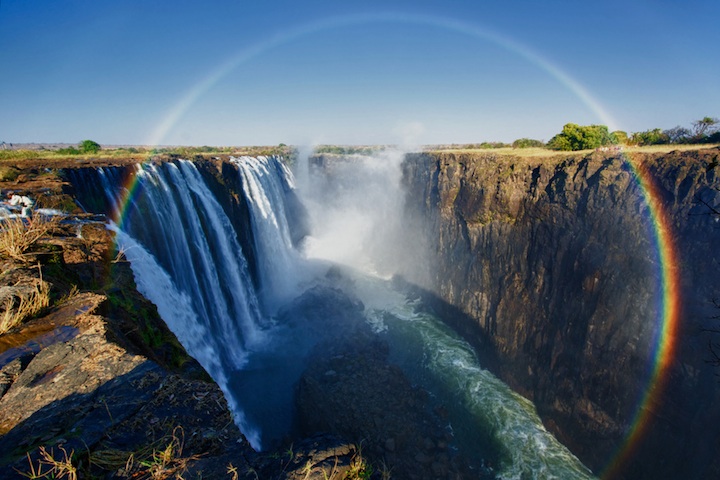The rainbow, a lovely occurrence in nature. The vibrant colors of a rainbow and the magic associated with their creation leave many people feeling awe-inspired. Rainbows can show up nearly anywhere in the world after a rainstorm, but a few select places are known for the constant and vivid displays of rainbows and occasionally double or lunar rainbows. The waterfalls that pour from mountains and the mist in the mountains with the natural sunlight shining through and the vast view of the rainforest in tropical islands, tranquil lakes, sunshine, and just enough moisture to provide foggy rays- all of these things create the right components to give you the highest chances of seeing a perfect rainbow.
Whether you are a traveler, a nature lover, or a photographer looking for the perfect shot to add to your portfolio, these places provide some of the best rainbow viewing opportunities. In this guide to the ten best places in the world to find a rainbow, you will discover destinations where nature more often than not puts on a colorful show, based on the official data by USA Today. So pack your bags, your camera, and an adventurous spirit as you set off to see rainbows across some of Earth's most stunning landscapes!
Check Out: List of Top 10 Countries with the Best Air Quality
List of Top 10 Best Places to See Rainbows
Here are the Top 10 Best Places to see Rainbows in the World along with the country they belong to:
| S.No | Place | Country/Location |
| 1 | Hawaii | United States |
| 2 | Victoria Falls | Zambia / Zimbabwe |
| 3 | Iguazu Falls | Argentina / Brazil |
| 4 | Skógafoss Waterfall | Iceland |
| 5 | Yosemite National Park | United States |
| 6 | Niagara Falls | United States / Canada |
| 7 | Irish Countryside | Ireland |
| 8 | Lake Louise / Banff / Jasper NP | Canada |
| 9 | Lake Neusiedl | Austria |
| 10 | Faroe Islands / Lofoten Islands | Denmark (Faroe) / Norway |
1. Hawaii, USA

Located at the intersection of light, rain, and clean tropical air, the Hawaiian rainbow is known throughout the world for its frequency and vividness. Thanks to trade winds and the mountainous terrain, short rain showers followed by sunshine create the optimal conditions to produce the rainbow phenomenon nearly every day. Rainbows are so commonplace in Hawaii that they have become deeply woven into local culture, appearing in local mythology, language, and even on license plates.
2. Victoria Falls, Zambia/Zimbabwe

Victoria Falls is one of the few places in the world where people can see moonbows, which are rainbows that form at night on a full moon. The falls consistently produce a mist, so when the mist is hit by moonlight or sunlight, to see a rainbow is almost certain to happen. Most of the time, this phenomenal sight can be viewed from the regularly used viewpoints such as Knife Edge Bridge or Devil’s Pool, in both the daytime and nighttime hours.
3. Iguazú Falls, Argentina/Brazil

Iguazú Falls is an incredible display located on the border between Argentina and Brazil. It has some of the most beautiful, colorful rainbow displays you will find on Earth, produced in part by the sheer volume of water being poured over the falls, causing mist to go high into the air. Any time a sunny day is accompanied by a light mist, you will see fantastic rainbows throughout the day. The viewpoints on either side of the falls provide a wide viewing area for seeing multiple and sometimes a complete full-circle rainbow.
4. Skógafoss, Iceland

Skógafoss is a powerful waterfall located in southern Iceland. It is known for its mist, where you will regularly spot a rainbow. You can walk right up to the base of the falls, and you will (when you're lucky) walk right into a rainbow’s channel. On brighter days, on occasion, you will see double rainbows, which makes Iceland’s already dramatic landscape even more surreal.
5. Yosemite National Park, USA

Yosemite National Park is abundant in landscape beauty, but it also has a rare natural phenomenon that can be enjoyed while you are there: moonbows. Moonbows are nighttime rainbows that occur during a full moon, and especially around Yosemite Falls, where the soft moonlight interacts with the waterfall mist. The chances of seeing moonbows are greatest in the spring and early summer when rainfall is common, which attracts photographers and nature lovers from all over the world.
Comments
All Comments (0)
Join the conversation